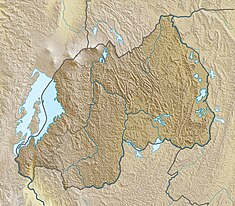
The Ruzizi is a river, 117 kilometres (73 mi) long, that flows from Lake Kivu to Lake Tanganyika in Central Africa, descending from about 1,500 metres (4,900 ft) to about 770 metres (2,530 ft) above sea level over its length. The steepest gradients occur over the first 40 kilometres (25 mi), where hydroelectric dams have been built. Further downstream, the Ruzizi Plain, the floor of the Western Rift Valley, has gentle hills, and the river flows into Lake Tanganyika through a delta, with one or two small channels splitting off from the main channel.
The Rusumo Hydroelectric Power Station, also known as the Rusumo Power Station, is a hydropower plant under construction, with initial planned capacity installation of 80 megawatts (110,000 hp) when completed. The project will involve the construction of a dam, with run of river design. A more expensive 90 megawatts (120,000 hp) reservoir design was considered before being abandoned in favor of an 80 MW project with a smaller environmental impact and an estimated cost of US$300 million compared to US$400 million for the bigger project. The World Bank announced on 6 August 2013 that it had approved loans totaling US$340 million towards the US$468.60 million needed for the project. In November 2013, the African Development Bank approved a loan of US$113 million towards completion of the project.
Nyabarongo I Hydroelectric Power Station is a 28 megawatts (38,000 hp) hydroelectric power station in Rwanda.
Muvumbe Hydroelectric Power Station is a 6.5 megawatts (8,700 hp) hydroelectric power station in the Western Region of Uganda.
Songwe Hydroelectric Power Station, also Songwe Power Station, is a proposed hydropower plant, with planned capacity installation of 180 megawatts (240,000 hp) when completed. Other related developments include the development of more dams for both power generation and irrigation purposes, and the creation of a Joint River Basin Authority.
Kopere Solar Power Station, is a planned 50 megawatts (67,000 hp) solar power plant in Kenya, the largest economy in the East African Community.
Ruzizi IV Hydroelectric Power Station, is a proposed hydro-power plant, with planned capacity installation of 287 megawatts (385,000 hp) when completed.
Sahofika Hydroelectric Power Station, also referred to as Sahofika Power Station, is a 205 megawatts (275,000 hp) hydroelectric power station under construction in Madagascar.
Kaptis Hydroelectric Power Station, also Kaptis Power Station, is a planned hydroelectric power plant in Kenya, with generation capacity of 15 megawatts (20,115 hp).
Boali Hydroelectric Power Station is a 38.75 megawatts (51,960 hp) hydroelectric power complex near Boali in the Central African Republic.
The Akanyaru Multipurpose Dam, is a planned dam across the Akanyaru River, at the international border between Rwanda and Burundi. The dam will create a reservoir with storage capacity of 333,000,000 cubic metres (1.1759784018×1010 cu ft). The water is expected to supply drinking water to an estimated 614,200 people in both countries. The reservoir is also expected to provide irrigation water to an estimated 12,474 hectares (30,820 acres) of agricultural land in Burundi and Rwanda, benefitting an estimated 24,948 farmers. The dam will also host Akanyaru Hydroelectric Power Station, with generating capacity of 14.5 MW (19,400 hp).
Grand Katende hydroelectric power station is a hydropower plant under construction in the Democratic Republic of the Congo, with installed capacity of 64 megawatts (86,000 hp). When completed, it will be operated by the Congolese electricity utility company, Société Nationale d'Électricité (SNEL).
The Zongo II Power Station, also Zongo 2 Power Station, is a hydroelectric power station across the Inkisi River that harnesses the energy of the Zongo Falls in the Democratic Republic of the Congo. Construction began on 14 March 2012 and concluded in 2018. The power station was officially inaugurated on 22 June 2018 by the President of the DR Congo, at that time, Joseph Kabila.
The Nyabarongo II Multipurpose Dam, is a multipurpose dam under construction across the Nyabarongo River in Rwanda. The dam will measure 48 metres (157 ft) high and 228 metres (748 ft) long, creating a reservoir with storage capacity of 846,000,000 cubic meters (8.46×1011 L). The reservoir is also expected to provide irrigation water to an estimated 20,000 hectares (49,000 acres) of land, downstream of the dam site. In addition, the dam will host Nyabarongo II Hydroelectric Power Station, with installed generating capacity of 43.5 megawatts.
Djermaya Solar Power Station (DSPS) is a planned 60 MW (80,000 hp) solar power plant in Chad. The solar farm is under development and is owned by a consortium comprising (a) Aldwych International Limited, a subsidiary of Anergi Group and (b) Smart Energies. The power station will be developed in phases. Phase 1, with capacity of 32 megawatts will be developed first. Phase 2, with capacity of 28 megawatts will be developed after Phase 1.

